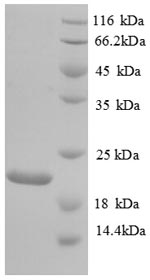Recombinant Human Urokinase-type plasminogen activator (PLAU) is expressed in E. coli and contains amino acids 21 to 173 of the protein. The protein carries an N-terminal 6xHis-tag, which makes purification and detection more straightforward. SDS-PAGE analysis shows a purity level that exceeds 90%, suggesting high quality for research applications. This product is designed for research use only and is not intended for clinical applications.
Urokinase-type plasminogen activator (uPA) is a serine protease that appears to be critical in converting plasminogen to plasmin, a key enzyme involved in fibrinolysis. It likely plays a significant role in extracellular matrix degradation and tissue remodeling, influencing processes such as cell migration and tissue repair. Scientists widely study uPA for its involvement in various physiological and pathological pathways, making it an important target in research.
Potential Applications
Note: The applications listed below are based on what we know about this protein's biological functions, published research, and experience from experts in the field. However, we haven't fully tested all of these applications ourselves yet. We'd recommend running some preliminary tests first to make sure they work for your specific research goals.
Based on the provided information, recombinant human PLAU is produced in an E. coli expression system as a partial fragment (21-173aa) with an N-terminal 6xHis-tag. PLAU is a eukaryotic serine protease that requires precise folding, disulfide bond formation, and proper tertiary structure for its enzymatic activity in plasminogen activation. E. coli, as a prokaryotic system, lacks the oxidative environment and chaperones necessary for correct disulfide bond formation and folding of complex eukaryotic proteins. The partial nature of the fragment (missing the signal peptide and potentially critical domains) further reduces the likelihood of correct folding and bioactivity. Purity >90% by SDS-PAGE is determined under denaturing conditions and does not confirm native folding or bioactivity. No validation data (e.g., enzymatic activity assays, circular dichroism) are provided. Therefore, the protein is highly likely to be misfolded and inactive, and applications should be considered high-risk without experimental validation.
1. Antibody Development and Characterization
This application is suitable as antibody generation primarily relies on linear epitope recognition, which is independent of folding status. The His-tag simplifies purification and immobilization for ELISA-based screening. However, if misfolded, generated antibodies may not optimally recognize conformational epitopes of native, properly folded PLAU in biological systems, limiting their utility for functional studies.
2. Biophysical Analysis
These studies are essential for determining folding status. Techniques should include circular dichroism spectroscopy to assess secondary structure, size-exclusion chromatography to evaluate oligomeric state, and thermal stability assays. However, the partial nature of the fragment limits insights into full-length PLAU.
Final Recommendation & Action Plan
Given the high probability of misfolding and inactivity due to E. coli expression and the partial fragment design, it is essential to validate the protein's folding and bioactivity before any application. The recommended action plan includes first performing functional assays (e.g., plasminogen activation assay) to confirm enzymatic activity and biophysical characterization (e.g., circular dichroism for secondary structure, size-exclusion chromatography for oligomeric state). If validation fails, consider using eukaryotic expression systems (e.g., mammalian or insect cells) for proper folding or obtain a commercially validated full-length PLAU. For immediate use, limit applications to antibody development with the understanding that antibodies may require additional validation against native protein, and avoid all functional studies until proper folding is confirmed.






